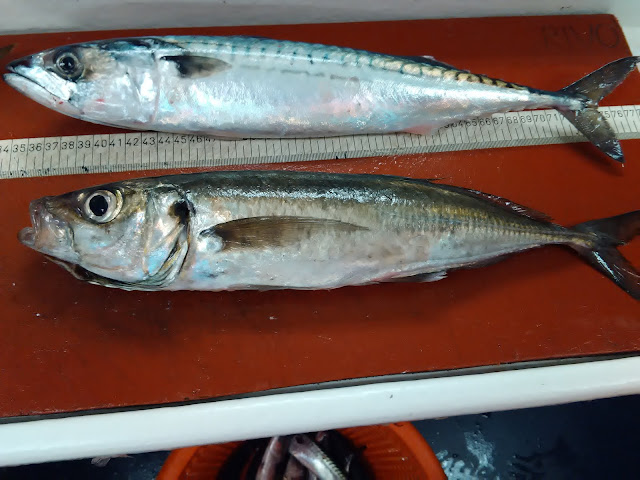During the final
transect, we were hoping to find a dense layer of blue whiting and finish with
one last fishing haul but the schools on the echograms were too
small and patchy to target with our pelagic trawl net. Hour upon hour passed as
we closed in on the end of the transect, growing more impatient by the minute.
We knew that we might not get the opportunity for one more haul…
Right as we made
our way up to the shelf slope, a strong signal appeared at a depth of about 300
metres: this was our chance! Soon afterwards, the net was shot and we trawled
through the whiting school, which now showed up as an extensive layer on the echograms. After a tow time of only 15 minutes, the net was hauled back in.
The school had
been more dense than expected. The net contained about 3.5 tons of blue
whiting, making it one of the largest hauls of the cruise. There was a high proportion
of larger size classes of blue whiting (> 30 cm) and compared to other
hauls, these fish were quite young, with many not older than 4-6 years. We also
caught some larger bycatch species; mostly hake, mackerel, argentines and horse
mackerel. Due to the shallower depth of this haul compared to the others, the mesopelagic
species were absent except for a single lanternfish and a snipe eel.
We promised a deep
sea haul, but unfortunately we ran out of time. At the end of transect, we
headed down passed the Isle of Lewis, through the Scottish Islands and down the
Irish Sea. The wind picked up again on Wednesday, making for a rougher sea than
the last few days. Steaming at about 15 knots, we are on schedule to arrive in
Cork in the morning. While everyone on board is busy cleaning up and packing
for the trip home, we are finishing the blog. For some of us, this will be the
last night on board, so we are sending you our best wishes once more as we are passing
through St. George’s Channel into the Celtic Sea.
Slán abhaile,
agus go n’éirigh on bothar libh.
Safe home, and
may the road rise with you.























































